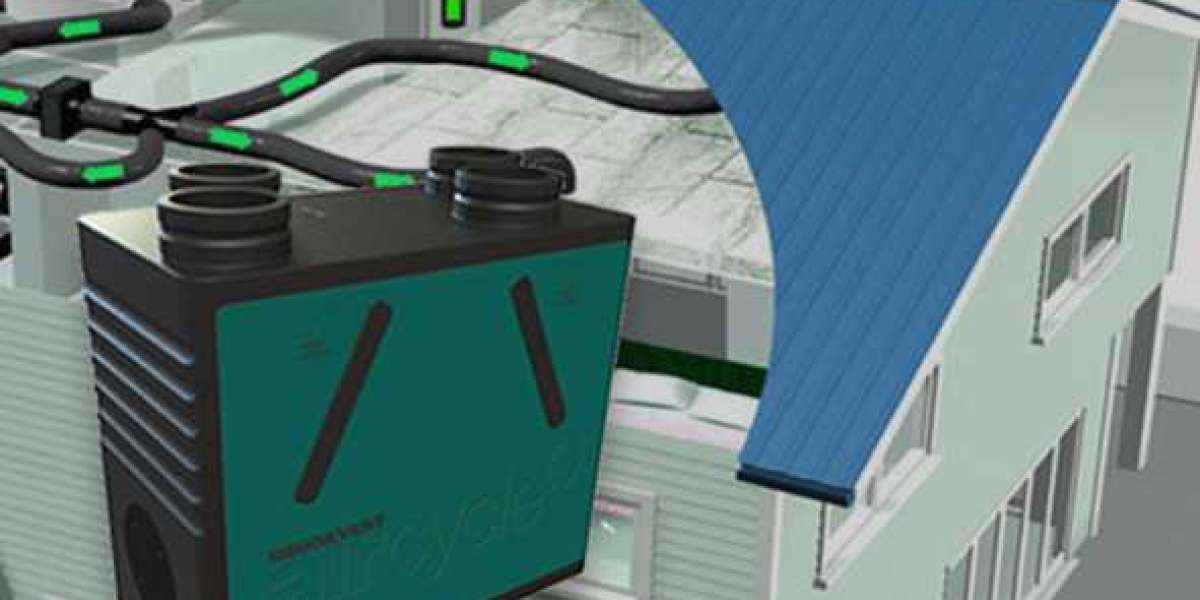Breathing clean, fresh air is essential for our health and well-being. Yet many of us unknowingly live in homes with poor indoor air quality. The culprit? Inadequate ventilation systems that fail to provide the necessary exchange of stale air for fresh outdoor air. This is where energy recovery ventilator (ERVs) come into play, offering a smart solution to improve your home's air quality while promoting energy efficiency. With their ability to transfer heat and moisture between incoming and outgoing airflow, ERVs enhance comfort and significantly reduce heating and cooling costs.
How an Energy-Recovery Ventilator Enhances Ventilation Efficiency
An energy-recovery ventilator (ERV) is crucial in improving ventilation efficiency. Exchanging stale indoor air with fresh outdoor air ensures a balanced airflow throughout your space. This process is vital for maintaining optimal indoor air quality and comfort.
The unique design of an ERV allows it to recover energy from the outgoing air while introducing new air. As warm, conditioned air exits your home; the system preconditions incoming fresh air using this transferred energy. This means less reliance on heating or cooling systems to maintain desired temperatures.
As a result, you enjoy fresher air and save significantly on energy costs. An ERV can reduce the workload on HVAC systems by up to 30%. Lower operational demands come with extended equipment lifespan and fewer maintenance issues.
Moreover, these devices help regulate humidity levels by transferring moisture between outgoing and incoming airflow streams. The controlled environment reduces mold growth risks while enhancing overall comfort.
An ERV optimizes ventilation rates without sacrificing efficiency, making it a smart choice for residential and commercial spaces looking to improve their indoor atmosphere.
The Hidden Health Risks of Poor Home Ventilation
Poor home ventilation can create many hidden health risks that often go unnoticed. When fresh air is not circulating properly, indoor pollutants accumulate. These can include dust, mold spores, and volatile organic compounds (VOCs) from common household products. Breathing in these contaminants over time may lead to respiratory issues.
Individuals with asthma or allergies might experience exacerbated symptoms due to stagnant air filled with irritants. Even those without pre-existing conditions could suffer from headaches or fatigue linked to poor air quality in their homes.
Moisture buildup is another concern associated with inadequate ventilation. High humidity levels can promote mold growth, significantly damaging physical health and property integrity. Mold exposure has been connected to various ailments, from skin irritation to more severe respiratory diseases.
Moreover, carbon dioxide levels may rise when ventilation is lacking, leading to feelings of dizziness and confusion among occupants. This becomes particularly critical in spaces where people gather for extended periods.
Children and the elderly are especially vulnerable; their developing bodies or weakened immune systems make them more susceptible to the adverse effects of indoor pollutants that thrive under poor ventilation conditions.
Choosing the Right Energy Recovery Ventilator for Your Space
Choosing the right energy recovery ventilator (ERV) for your space involves considering several key factors. First, assess the size of your home or commercial building. The ERV should be rated to handle the specific airflow needs based on square footage and occupancy levels.
Next, think about the climate conditions in your area. Some ERVs are better suited for humid climates, while others perform well in drier environments. Understanding local weather patterns can help you select a model that maximizes efficiency year-round.
Energy efficiency ratings are another crucial factor. Look for models with ratings of high Energy Efficiency Ratio (EER) and Seasonal Energy Efficiency Ratio (SEER). These numbers indicate how effectively an ERV uses power to improve air quality without excessively raising utility bills.
Don’t overlook noise levels, either. Some units operate silently, while others may produce noticeable sound during operation. Choose one that fits your comfort level, especially if installed near living spaces or work areas.
Consider installation requirements and compatibility with existing HVAC systems. A professional assessment can ensure seamless integration, enhancing the unit's performance and longevity in your environment.
Smart Home Integration for Modern Air Quality Solutions
Smart home technology is revolutionizing how we manage air quality in our living spaces. Energy-recovery ventilators can seamlessly integrate into a smart home ecosystem, enhancing your control over indoor environments.
With a few taps on your smartphone or voice commands to your virtual assistant, you can monitor and adjust ventilation settings. This means fresh air flow can be optimized according to real-time data on outdoor air conditions and indoor humidity levels.
Some advanced energy-recovery ventilators even come equipped with sensors that detect pollutants and allergens in the air. When these contaminants are detected, the system automatically adjusts airflow to maintain optimal air quality without manual intervention.
Integration doesn’t stop there; you can coordinate your energy-recovery ventilator with other smart devices like thermostats, fans, and humidifiers for an all-in-one approach to comfort. The result is not just cleaner air but also improved energy efficiency throughout the entire home.
As more homeowners embrace smart technology, the ability to create customized schedules for ventilation systems becomes increasingly valuable. Tailoring these systems ensures fresh air circulates when needed—enhancing health while providing peace of mind.
Energy Recovery-Ventilator Benefits for Commercial Buildings
Energy-recovery ventilators (ERVs) transform how commercial buildings manage air quality. These systems capture energy from exhausted indoor air and transfer it to incoming fresh air. This process significantly reduces the energy required for heating or cooling, making them an economical choice for businesses.
Installing an ERV can improve indoor air quality by exchanging stale indoor air with filtered outdoor air. This helps dilute pollutants and allergens accumulating in commercial spaces, enhancing occupant comfort and health.
Furthermore, regulatory compliance becomes easier with ERVs. Many local regulations emphasize maintaining specific indoor environmental standards. An effective ventilation system supports adherence to these guidelines while promoting a healthier workplace atmosphere.
The investment in energy-recovery ventilators pays off over time through lower utility bills. Businesses can experience substantial savings on their HVAC costs as they rely less on traditional heating and cooling methods.
Using ERVs enhances sustainability efforts within the building sector. By reducing energy consumption and minimizing waste, businesses contribute positively toward environmental goals while creating more efficient operations.
Long-Term Cost Savings through Efficient Air Exchange
Investing in an energy-recovery ventilator (ERV) can lead to significant long-term cost savings. These systems efficiently exchange stale indoor air with fresh outdoor air while minimizing energy loss. Transferring heat and moisture reduces the demand for heating and cooling systems.
With better air quality comes improved comfort. As your HVAC system operates more effectively, it doesn’t have to work as hard to maintain desired temperatures. This translates into lower utility bills every month. Moreover, ERVs help prevent mold growth and structural damage caused by poor ventilation. Addressing these problems early can save homeowners from costly repairs later.
This technology also benefits commercial buildings. With stricter building codes focusing on sustainability, implementing an ERV system can keep operational costs low while complying with regulations.
As awareness of indoor air quality continues to grow, investing in an energy-recovery ventilator becomes not just a smart financial choice but a necessary one for maintaining healthful environments at home or work.
Key Features to Look for in an Energy-Recovery Ventilator
Prioritize High Energy Recovery Efficiency
Select an ERV unit with a high energy recovery rate to ensure optimal heat and moisture exchange. This reduces HVAC strain, improving comfort and lowering energy bills.
Match Airflow Capacity to Your Space
Proper airflow ensures consistent ventilation without drafts. Choose a model with adjustable CFM settings to meet your home's or commercial environment's demands.
Choose Quiet Operation for Greater Comfort
Look for ENERGY STAR-rated ventilators that operate quietly, especially at higher speeds. Low-noise units contribute to a more peaceful and relaxing indoor atmosphere.
Simplify Upkeep with Easy Maintenance Access
Opt for ERVs with easy-access filter panels and tool-free servicing. Simplifying maintenance extends unit lifespan and ensures reliable performance over time.
Opt for Smart Features That Enhance Control
Modern ERVs offer app compatibility and home automation integration, allowing you to monitor air quality, adjust airflow, and receive alerts from your smartphone.
Future Trends in Air Quality and Sustainable Ventilation Systems
As awareness of air quality rises, the demand for sustainable ventilation solutions also increases. Energy-recovery ventilators (ERVs) are at the forefront of this movement. They not only improve indoor air quality but also enhance energy efficiency.
Smart technology integration is making ERVs even more appealing. Sensors and automation can monitor air quality in real-time and adjust ventilation, ensuring optimal performance while minimizing energy use.
Another trend is the focus on renewable energy sources to power these systems. Solar panels can complement ERVs, creating a self-sustaining environment that reduces reliance on traditional electricity grids.
There’s also a growing interest in biophilic design principles—integrating natural elements into building designs to promote well-being and sustainability. Incorporating plants alongside ERV systems may further purify indoor air while enhancing aesthetics.
Regulatory frameworks are evolving to support healthier indoor environments. Governments are encouraging or mandating improved ventilation standards in new constructions and renovations, pushing industries toward adopting advanced technologies like energy-recovery ventilators for better public health outcomes.
Conclusion
Improving air quality in your home or commercial space is crucial for health and comfort. An energy recovery ventilator plays a significant role in achieving this goal. By efficiently exchanging stale indoor air with fresh outdoor air, these systems enhance ventilation without sacrificing energy efficiency. Health risks associated with poor ventilation can be serious. Allergens, pollutants, and excess humidity often linger in poorly ventilated spaces. Energy-recovery ventilators help mitigate these issues by maintaining optimal indoor conditions. Smart home integration features are also gaining popularity among modern consumers seeking convenience and control over their indoor environments.
FAQs
What is an energy recovery ventilator?
An energy recovery ventilator (ERV) improves indoor air quality by exchanging stale indoor air with fresh outdoor air while transferring heat and humidity between the two streams. This process minimizes energy loss, making heating or cooling more efficient.
How does an ERV differ from a regular ventilation system?
Unlike traditional ventilation systems, which often directly exchange outside air without recovering energy, an ERV captures thermal energy during this exchange. It helps maintain consistent indoor temperature and humidity while reducing HVAC operating costs.
Can I install an ERV myself?
While some homeowners may choose to install their ERVs, hiring a professional for proper installation is advisable to ensure optimal performance and efficiency. Professionals can also assess your space's unique needs before selecting the right model.
Are there any maintenance requirements for ERVs?
Regular maintenance includes cleaning or replacing filters every few months, inspecting ductwork for leaks or blockages, and checking motor functions annually to ensure maximum efficiency.
What type of spaces benefit most from using an ERV?
Energy-recovery ventilators are beneficial in various settings—residential homes with tight construction standards or commercial buildings requiring strict ventilation control due to occupancy loads can all experience improved comfort levels through effective airflow management.
Related Business Listings |








